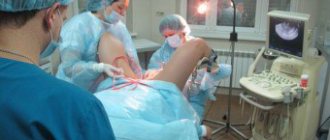What is the danger of blood stagnation in the uterus?
From the uterine cavity, fluids (menstrual flow and blood leaking from small blood vessels) are discharged through the cervical canal. If for any reason there are obstacles along the way and the patency of the cervix is disrupted, the uterus begins to stretch as its cavity gradually fills with fluid. A painful and dangerous condition occurs, which is called hematometra.
The consequence of the pathology is not only the appearance of severe pain. Blood that stagnates in the uterus can fester, as pathogenic microorganisms quickly begin to multiply in it. This causes pyometra, a purulent inflammation of the uterine mucosa. Pus enters the blood vessels and causes blood poisoning. When it enters the abdominal cavity, peritonitis develops. Purulent endometritis often leads to infertility.
After pyometra, which appears as a result of the formation of hematometra, adhesions and scars remain in the uterine cavity.
Video: What is a hematometra, why is it dangerous
Hematometra: what is it and what is the cause of the condition
The internal female genital organs are represented by the appendages, the body and cervix, and the vagina. They are all connected to each other. The uterus is a smooth muscle reproductive organ consisting of a body and a cervix. The latter is partially located in the vagina. The cervix has an external os (from the vagina) and an internal os (closer to the uterine cavity). These places have a special structure with a physiological narrowing of the channel. This is a “natural defense” against infection from entering the uterine cavity from the outside. Menstrual blood is the exfoliated surface layer of the endometrium mixed with blood. These secretions must move from the uterine cavity to the outside. The process occurs passively under the influence of gravity, as well as as a result of contraction of the myometrium. Lead to the hematometer:
- disturbance of contractile activity of the uterus - usually after childbirth, curettage;
- obstruction at the level of the internal or external pharynx - with spasm, tumor, intrauterine adhesions.
Congenital anomalies
Sometimes they can be detected in childhood, but most often they are diagnosed after a girl starts menstruating. Congenital pathologies may be the formation of adhesions and septa in the uterus (bicornuate uterus), narrowing of the cervical canal or irregular shape of the vagina, the presence of a transverse septum in it.
Another reason for the inability of blood to exit the uterus is the absence of holes in the hymen. It can be continuous and abnormally dense as a result of the peculiarities of the intrauterine formation of organs in a girl. Overgrowth of the holes also occurs due to inflammation of the genitals suffered in childhood.
Acquired pathologies
They are divided into organic and functional.
Organic are, for example, polyps in the cervix, fibroid nodes that cover the internal os of the cervix, as well as malignant tumors of the uterus or cervical canal. The cause of stagnation of blood in the uterine cavity is the incomplete removal of the fetus and placenta during an abortion and their entry into the cervical canal. A hematometra occurs because it becomes blocked by a large blood clot formed after surgery. Sometimes an obstacle to the passage of blood is adhesions and scars that form in the cervix as a result of injury to it with surgical instruments or exposure of the mucous membrane to radio radiation during radiation therapy.
The functional reasons for the formation of hematometra include:
Based on its origin, this pathology is divided into several types.
Postpartum hematometra. Stagnation of blood in the uterus occurs due to manual separation of the placenta, the occurrence of synechiae (adhesions) and scars after removing the child by cesarean section. Blood removal becomes impossible if the uterus stretches too much and its contractility weakens significantly. This happens when carrying a large fetus or several at the same time. The accumulation of blood in the uterus occurs when the intrauterine device is not installed correctly.
Hematometra after curettage. It occurs due to damage to blood vessels located in the uterine cavity and bleeding during surgical procedures (removal of the fetus during a frozen pregnancy, curettage for endometrial pathologies, abortions).
Hematometra due to blockage of the genital tract when the vagina is clogged with adhesions or blocked by a neoplasm.
Hematometra due to narrowing of the cervical canal. Stenosis occurs due to spasm, mechanical damage, or compression by a tumor.
During menopause, the cause of blood stagnation in the uterus is an age-related decrease in the elasticity of the uterine muscles and a decrease in their contractility. The size of the uterus decreases, the lumen of the cervical canal narrows. Sometimes uterine prolapse occurs. All this leads to impaired excretion of scanty and irregular menstrual flow, resulting in the development of hematometra. In addition, after a decrease in the production of female sex hormones in the ovaries during this period, the risk of malignant tumors increases significantly. In this case, uterine bleeding occurs, and pathological growth of the tissues of the cavity and cervix occurs.
Hematometra is sometimes found in women at the very beginning of pregnancy, especially after IVF. Pathology indicates a threat of miscarriage due to placental abruption and the presence of blood clots in the uterine cavity. In this case, the pregnant woman experiences spotting and spotting. Ectopic pregnancy can also cause blood accumulation.
Note: There are times when a woman’s next period does not come, but instead, after a short delay, faint pink discharge appears and a barely noticeable pain occurs in the groin area. Such symptoms are similar to those of hematometra, but most likely they are associated with pregnancy. And pinkish discharge in this case occurs when the embryo is implanted into the endometrium.
The possibility of pregnancy after eliminating a pathology such as hematometra depends on its origin, the severity of the consequences and the general condition of the organs of the reproductive system.
Symptoms and signs
Signs of blood stagnation in the uterine cavity may be subtle if the accumulation of blood is small and there is no inflammatory process. Symptoms of hematometra are:
- feeling of heaviness in the lower abdomen;
- disappearance of menstruation (amenorrhea);
- sudden cessation of bleeding from the genitals after childbirth or uterine curettage;
- spasmodic pain in the lower abdomen, aggravated by sudden movements and physical activity;
- increased body temperature;
- the appearance of weakness, dizziness, increased heart rate;
- fainting is possible.
Pathophysiology
Hematometra develops when the uterus becomes distended due to blood caused by obstruction of the menstrual cycle at the level of the uterus, cervix or vagina. The disease, resulting from partial or complete obstruction of the lower genital tract, can be congenital or acquired. Congenital anomalies include:
Acquired reasons:
Illness after cesarean section can be caused by improper suturing of the anterior and posterior uterine walls, creating a pouch where blood collects for several years. Postpartum hematometra may take several weeks to appear. Characterized by increased temperature, disappearance of breast milk and severe pain in the lower abdomen.
USEFUL INFORMATION: Multifollicular ovaries: clinical picture, diagnosis and treatment
Diagnostics
First of all, if such a pathology is suspected, a pregnancy test is performed and an ultrasound is performed to confirm the result. This study can also detect fluid accumulation in the uterus.
During a gynecological examination and palpation, the doctor assesses the size of the uterus, cervix, mobility and size of the appendages, and the location of pain. The nature of the complaints, the time of appearance of unusual symptoms, and the general condition of the patient are taken into account.
Hysteroscopy is performed - examination of the cavity and cervix using optical technology. The method makes it possible to detect the cause of hematometra (the presence of polyps or fibroids). This procedure also has a therapeutic purpose, as it allows you to immediately remove detected tumors.
Using a special probe inserted into the uterus through the cervix, the presence of blood in the cavity is confirmed. A microscopic analysis of the smear and bacteriological culture of the mucous contents of the vagina and cervix are performed to detect infectious agents.
If there is a suspicion of a malignant nature of changes in tissues, a biopsy and histological examination of samples of the mucous membranes are performed.
Treatment
Treatment is aimed not only at eliminating the symptoms of hematometra and removing blood from the uterus, but also at eliminating the causes of its accumulation. In this case, most often only drug therapy is required, as well as probing of the uterine cavity to empty it of stagnant fluid. Blood can be removed by vacuum aspiration.
When treating hematomas, the following medications are used:
- increasing uterine contractility (oxytocin, ergotal, ergotamine);
- relieving muscle spasms of the uterus and cervix (no-spa, papaverine, drotaverine);
- nonsteroidal anti-inflammatory drugs that relieve pain and reduce fever (ibuprofen, naproxen, analgin, aspirin);
- hemostatic agents (etamsylate);
- antibiotics (macrocef);
- vitamins A, B, C, iron preparations to eliminate anemia and the consequences of blood loss;
- hormonal drugs. Duphaston contains progesterone, which promotes loosening and swelling of the endometrium. With its help, it is easier to cleanse the uterine cavity from the remains of the affected mucous membrane.
If, after using medications, the hematometer cannot be completely eliminated, surgical intervention is resorted to. For example, if necessary, a puncture or incision is made in the hymen. In case of pathology after abortion or childbirth, the uterine cavity is curetted.
In order to prevent the occurrence of such an anomaly as hematometra, it is necessary to promptly consult a doctor for the treatment of inflammatory diseases of the reproductive organs. It is important to try to avoid abortions by using reliable contraception.
Examination of a girl in adolescence when the first signs of delayed sexual development appear is of great importance. Using ultrasound and other diagnostic methods, a gynecologist will be able to detect abnormalities in the structure of the reproductive organs. Treatment will help eliminate them at an early age.
Hematometra is an accumulation of blood in the uterine cavity associated with a violation of the outflow of post-abortion, postpartum or menstrual discharge through the cervical canal.
Hematometra is not an independent pathology; it is one of the manifestations of congenital developmental pathologies or acquired diseases of the vagina and uterus.
Often, the accumulation of blood in the uterus is combined with hematocolpas and hematosalpinx, that is, with the accumulation of blood in the vagina and fallopian tubes. Untimely evacuation of the contents of the hematometra threatens the development of purulent-septic complications, which can lead to the death of the patient. In this regard, the issues of preventing the formation of hematometra, its diagnosis and treatment are very relevant for modern obstetrics and gynecology.
Hematometra after medical termination of pregnancy
A desired and expected child. A pregnancy that proceeds without any complications or unpleasant surprises. Relatives and friends who are in happy and anxious anticipation. And as a logical ending – a successful, easy birth.
The happy mother goes home, after which the newly “plump” family throws a grand celebration, and the happy father goes with his friends to the nearest store to buy high-grade liquid, and no one stops him from doing this.
Would you say this is an ideal situation that practically never occurs in real life? Nothing like this! This happens quite often, and only sometimes events develop according to the worst scenario (difficult birth with complications).
It also happens that no one needs a child, but usually this is explained by quite prosaic reasons: building a career, being busy, or a sudden romance when a woman for some reason decides that the baby will ruin the new relationship.
And then, after a sleepless night (“I’m not ready yet, someday later...”) she goes for an abortion.
The procedure goes quite “successfully”, but after some time the failed mother begins to feel sharp attacks of pain, and her general condition rapidly deteriorates. She goes to the doctor, who, after a consultation and ultrasound, diagnoses hematometra. There will be quite a long treatment ahead, possibly a repeat operation and a subsequent period of rehabilitation.
Diagram of the “hematometra” disease
Unfortunately, such a development of events is not so incredible, and the accumulation of blood in the uterine cavity (and this is the definition of hematometra) can indeed be provoked by an abortion.
And if you are not ready to risk your own health, you should not ignore the signals sent by the body (more about them below).
We sincerely hope that this will not affect you, but it’s still worth trying to figure out what it is – a hematometer!
Attention! Dear women! When a doctor at a antenatal clinic, where you came for a referral for an abortion, recommends that you think again and carefully weigh everything, you can believe that this is not moralizing at all.
You will deal with ethical problems yourself, but doctors will have to deal with the consequences of termination of pregnancy (and hematometra is often caused by this).
And if so, we repeat, it’s worth thinking carefully about everything again!
Main causes and risk factors
As we have already found out, abortion is often to blame for the hematometer, but here it is very important to understand that “often” does not mean “always.”
Therefore, you should not engage in self-deception and ignore quite obvious symptoms only on the grounds that you never terminated your pregnancy.
In general, the following factors should cause reasonable concern (and, especially note, prompt a visit to the doctor):
- Polyp of the cervical canal. The disease is very dangerous, but most often it is diagnosed at the age of 40–50 (or even later), so there is no particular reason to panic. But even if you get sick, the likelihood that a polyp will provoke the development of hematometra is quite small.
- Postpartum period. The increased risk is associated not so much with a complete restructuring of a woman’s body, but with inevitable ruptures and injuries of the birth canal, no matter how easy the birth of a baby may seem. Therefore, home birth, which has become fashionable recently, is in a certain sense a lottery, because it is almost impossible for a non-specialist to notice internal bleeding in time.
- Abortion. The main suspect in the occurrence of hematometra, and you must understand that this applies to both professionally performed manipulation and criminal abortion.
Abortion is the main cause of hematometra and a number of other diseases
Symptoms and clinical manifestations
The main and often the only sign of hematometra is pain in the lower abdomen, which from time to time becomes cramping. However, sometimes the disease occurs without any discomfort.
- A feeling of heaviness in the stomach that cannot be explained by a heavy lunch or dinner.
- Weak or absent discharge after a medical abortion, the “harmlessness” of which, by the way, is greatly exaggerated.
- Abrupt cessation of bleeding after abortion or curettage.
- An increase in body temperature, which is often mistaken for a symptom of a common cold.
- Amenorrhea (prolonged absence of menstruation).
Attention! Often, hematoma occurs with virtually no external manifestations. It also happens that the symptoms are mild and are perceived by the patient without due attention (“it hurts and stops”). Therefore, it is strictly not recommended to ignore any discomfort, pain, fever, increase in temperature or any other signs that not everything is all right with you!
Diagnostics
The hematometer usually does not cause any difficulties for a qualified doctor, and the manipulations and procedures are practically standard:
- A detailed conversation with the patient. Are you laughing? Completely in vain! Firstly, this creates trust between the woman and the doctor, and secondly, the patient’s story (if she does not hide anything from the gynecologist) is the basis for further effective therapy.
A detailed conversation with a gynecologist is the key to a more accurate diagnosis
Let us repeat once again: your health depends on how much you help the doctor. Therefore, you should not “participate” in making a diagnosis, especially if you encounter medicine once a year during preventive examinations.
Treatment
Hematometra is one of those diseases that is very rarely treated through full-scale surgery.
It is important to understand that the main goal that a qualified doctor will strive for is not the relief of symptoms, but getting rid of the causes of the disease (that is, eliminating the contents of the uterine cavity), for which several methods can be used:
Drug therapy
- Drugs that stimulate uterine contractions (methylergometrine, ergotal, ergometrine maleate, ergotamine; they are also called uterotonics). The list of contraindications is quite impressive, so they must be taken strictly (!) after consultation with a gynecologist.
- Antispasmodics. They relax the muscles, thereby promoting the removal of blood from the uterine cavity (no-spa, papaverine).
Instrumental procedures
Diagram of the hysteroscopy process
- Probing and hysteroscopy. Used for severe blockage of the uterine canal. However, if the hematoma is accompanied by the development of an infectious process, the procedures should be supplemented by complete sanitation of the uterine cavity followed by the prescription of antibiotics.
- Vacuum aspiration. It is also often popularly called “mini-abortion”, which from an academic point of view is not entirely true, but from a practical point of view it fully reflects the essence.
Effective treatment of hematometra with folk remedies (which you will be promised on some “profile” sites) is a myth that can lead to very sad consequences. Herbal medicine and homeopathy can indeed be useful, but only as supportive and calming therapy. It is strictly not recommended to replace traditional treatment with them!
Prevention
It is impossible to completely insure yourself against hematometra, but by following simple recommendations, you can and should minimize the risk of getting sick:
- Periodic (1-2 times a year, if there is no cause for concern) visit to the gynecologist.
- Responsible attitude towards possible pregnancy, because abortion is a big risk of developing not only hematomas, but also a dozen other dangerous conditions.
- Timely treatment of any infectious and inflammatory diseases of the pelvic organs (primarily endometritis, vulvovaginitis and salpingoophoritis).
- Compliance with personal hygiene rules.
Terms and Definitions
A cervical canal polyp is a benign formation located in the canal between the uterus and vagina. The surface of the polyp is lined with columnar epithelial cells.
Source: https://gemoglobin.top/gematometra-posle-medikamentoznogo-preryvanija/
Causes
The causes leading to the occurrence of hematometers are divided into congenital and acquired. Congenital causes include structural anomalies of the internal genital organs:
- vaginal atresia;
- intrauterine septum;
- intrauterine synechiae;
- atresia of the cervical canal.
If these anomalies are not diagnosed in childhood, then with the onset of menstrual function, a hematometra is formed.
For the first time, a girl should be examined by a specialist even before the onset of puberty - this allows for timely diagnosis of possible anomalies in the development of the genital tract.
Acquired causes include the following conditions:
- myomatous node located in the area of the internal uterine os;
- large polyp of the cervical canal;
- cervical cancer;
- endometrial cancer;
- blockage of the cervical canal with a large blood clot, a section of the placenta, or a fragment of the fertilized egg remaining after an abortion;
- cicatricial stenosis of the cervix caused by radiation therapy, surgery;
- spasm of the cervical canal after curettage of the uterine cavity or spontaneous abortion in the early stages.
Hematometra after childbirth (lochiometra) is one of the complications of the postpartum period, the causes of which can be:
- overdistension of the uterus (multiple pregnancy, large fetus, polyhydramnios);
- weakness of labor;
- scars on the uterus;
- hemorrhagic shock;
- manual separation of the placenta.
Causes of the pathological condition
The uterus is a smooth muscle, hollow, pear-shaped organ consisting of a body and a cervix, part of which is located in the vagina. There is a narrow canal in the cervix, which opens with the internal and external pharynx into the uterine cavity and vagina, respectively.
The internal and external pharynx are even more narrowed than other parts of the cervical canal, due to the greater number of connective and elastic fibers located between the smooth muscle fibers. Through the cervical canal, the uterine cavity communicates with the vagina. The occurrence of any obstacle along this path or disruption of contractions of the uterine muscles causes blood retention in its cavity.
This pathological condition may be of the following nature:
- Organic - in the presence of a mechanical obstruction to the outflow of blood.
- Functional - when, for various reasons, muscle spasm occurs in the area of the internal os of the cervical canal or impaired contractility of the muscles of the uterine body (hypotonia or atony), as a result of which there is no possibility of increasing pressure in its cavity and expelling blood.
In obstetric and gynecological practice, the initial diagnosis is formulated (usually) indicating the symptom itself and the condition that resulted in the bleeding, but the direct cause of the pathology is not indicated (before examination), for example:
- Hematometra after curettage, which could be carried out for therapeutic and/or diagnostic purposes (
Forms
Taking into account the reason underlying the pathological mechanism of development of blood accumulation in the uterine cavity, its following forms are distinguished:
- hematometer after childbirth;
- hematometer after intrauterine manipulation;
- hematometra resulting from obstruction (obstruction) of the cervical canal and/or vagina.
Hematometra is not an independent pathology; it is one of the manifestations of congenital developmental pathologies or acquired diseases of the vagina and uterus.
Hematometra: treatment after medical abortion, childbirth, cesarean section, curettage, etc.
A desired and expected child. A pregnancy that proceeds without any complications or unpleasant surprises. Relatives and friends who are in happy and anxious anticipation. And as a logical ending – a successful, easy birth.
The happy mother goes home, after which the newly “plump” family throws a grand celebration, and the happy father goes with his friends to the nearest store to buy high-grade liquid, and no one stops him from doing this.
Would you say this is an ideal situation that practically never occurs in real life? Nothing like this! This happens quite often, and only sometimes events develop according to the worst scenario (difficult birth with complications).
It also happens that no one needs a child, but usually this is explained by quite prosaic reasons: building a career, being busy, or a sudden romance when a woman for some reason decides that the baby will ruin the new relationship.
And then, after a sleepless night (“I’m not ready yet, someday later...”) she goes for an abortion.
The procedure goes quite “successfully”, but after some time the failed mother begins to feel sharp attacks of pain, and her general condition rapidly deteriorates. She goes to the doctor, who, after a consultation and ultrasound, diagnoses hematometra. There will be quite a long treatment ahead, possibly a repeat operation and a subsequent period of rehabilitation.
Scheme of the “hematometra” disease
Unfortunately, such a development of events is not so incredible, and the accumulation of blood in the uterine cavity (and this is the definition of hematometra) can indeed be provoked by an abortion.
And if you are not ready to risk your own health, you should not ignore the signals sent by the body (more about them below).
We sincerely hope that this will not affect you, but it’s still worth trying to figure out what it is – a hematometer!
Attention! Dear women! When a doctor at a antenatal clinic, where you came for a referral for an abortion, recommends that you think again and carefully weigh everything, you can believe that this is not moralizing at all.
You will deal with ethical problems yourself, but doctors will have to deal with the consequences of termination of pregnancy (and hematometra is often caused by this).
And if so, we repeat, it’s worth thinking carefully about everything again!
Symptoms of hematometra
The clinical picture is determined by the following factors:
- the cause of the development of pathology;
- the volume of blood accumulated in the uterine cavity;
- the duration of the pathology.
The formation of hematometra in a woman can be assumed in the event of a sudden cessation or significant decrease in the amount of uterine discharge after intrauterine manipulation, abortion or childbirth.
The main symptoms of hematometra in teenage girls with congenital anomalies of the genital tract are:
- prolonged absence of menstrual bleeding (false form of amenorrhea);
- feeling of heaviness in the lower abdomen;
- cramping pain in the lower abdomen.
With the rapid development of hematomas and a significant volume of blood accumulated in the uterus, signs of internal bleeding appear:
- severe weakness;
- dizziness;
- darkening in the eyes, flashing “flies” before the eyes;
- tachycardia;
- decreased blood pressure;
- feeling of lack of air;
- pale skin;
- fainting.
The blood accumulated in the uterus is an excellent breeding ground for pathogenic microorganisms, so if the hematometra remains undiagnosed and is not removed, inflammation quickly develops against its background (endometritis, metroendometritis, pyometra). In this case, the patient’s condition rapidly deteriorates: the body temperature rises to febrile levels, which is accompanied by tremendous chills and a sharp deterioration in general condition, pain in the lower abdomen intensifies, and can radiate to the lumbar region or take on a girdling character.
Recovery
When the gynecological cleansing procedure was carried out, the first thing that interests the girls is how long they stay in the hospital after curettage. If there are no complications, the patient can leave the clinic on the day of the cleaning. In other situations, she will have to stay in a medical facility until she fully recovers.
Here are the recommendations doctors give after curettage so that recovery does not take much time:
- Sexual activity is not allowed for 3 weeks;
- To prevent unwanted pregnancy, you should use a condom for six months after surgery;
- During the first month, hygiene procedures are performed only in the shower; it is unacceptable to take a bath or visit the sauna;
- When menstrual bleeding occurs, you should use pads, not tampons;
- A woman needs to limit physical activity for two weeks to prevent bleeding.
Your doctor should tell you how to recover after a miscarriage and cleansing. If the patient had complications, he will advise her on physical procedures and also tell her how to behave during the rehabilitation period.
Diagnostics
Diagnosis of hematometra is carried out by an obstetrician-gynecologist based on clinical symptoms, patient complaints, gynecological examination data and instrumental research methods.
When conducting a bimanual vaginal examination, an enlarged uterus, which is painful on palpation and usually has a soft consistency, is determined. If a hematometra has formed in a teenage girl, then there is a need to differentiate it from a normal intrauterine pregnancy. For this purpose, an ultrasound of the pelvic organs is prescribed and a pregnancy test is performed. With a hematometer, ultrasound examination detects the presence of liquid contents and large blood clots in the uterine cavity. This method also allows us to identify possible uterine pathological formations, for example, a myomatous node or polyp.
To confirm the diagnosis, probing of the uterine cavity through the cervical canal is performed. With a hematometer, the insertion of a probe into the uterine cavity is accompanied by the release of blood.
In cases that are difficult to diagnose, hysteroscopy is indicated. This method of endoscopic diagnosis allows not only to reliably determine the presence of hematometra, but also to find out the cause of its occurrence, as well as carry out the necessary therapeutic measures during the same procedure.
If a secondary infection or inflammatory process is suspected, it is necessary to perform a bacteriological examination of the uterine discharge. This makes it possible to identify the causative agent of infection and determine its sensitivity to antibacterial drugs (antibioticogram).
Treatment of hematometra
The main goals of treating hematometra are:
- evacuation of blood from the uterine cavity;
- eliminating the cause that caused the development of this pathological condition;
- ensuring free outflow of contents from the uterine cavity.
In cases where the formation of hematometra is associated with blockage of the cervical canal with pieces of the placenta, blood clots or remnants of the fertilized egg, emptying of the uterine cavity occurs already at the stage of diagnostic probing.
With uterine atony, drug stimulation of its contractility is necessary. For this purpose, uterotonics (methylergometrine, ergot alkaloids, oxytocin) are prescribed. If the outflow of blood from the uterine cavity is difficult as a result of severe cervical spasm, the prescription of antispasmodics is indicated.
To prevent inflammatory complications, as well as for pain relief, non-steroidal anti-inflammatory drugs (Ketonal, Nimesulide, etc.) are used.
In cases where the above measures do not lead to complete emptying of the uterus, indications arise for vacuum aspiration of the uterine contents.
If there are anatomical formations (polyps, septums, myomatous nodes) that impede the outflow of blood from the uterine cavity, they are removed endoscopically.
With the development of complicated hematomas, there may be indications for removal of the uterus (supravaginal amputation of the uterus, hysterectomy).
Untimely evacuation of the contents of the hematometra threatens the development of purulent-septic complications, which can lead to the death of the patient.
Prevention
Prevention of hematometra involves regular monitoring of the woman by a gynecologist. For the first time, a girl should be examined by a specialist even before the onset of puberty - this allows for timely diagnosis of possible anomalies in the development of the genital tract. If a girl has not started menstruating before the age of 16, it is necessary to conduct an in-depth gynecological examination.
Other methods of preventing hematomas are:
- pregnancy planning;
- use of modern methods of contraception that avoid induced abortions;
- rational management of pregnancy, childbirth and the postpartum period;
- early attachment of the baby to the breast and breastfeeding (this promotes the production of oxytocin, which stimulates uterine contractions in the postpartum period);
- control over timely emptying of the bladder in the postpartum period.
Consequences and complications
If treatment is not started in a timely manner, hematometra can lead to the development of serious complications:
Video from YouTube on the topic of the article:
Education: graduated from the Tashkent State Medical Institute with a degree in general medicine in 1991. Repeatedly took advanced training courses.
Work experience: anesthesiologist-resuscitator at a city maternity complex, resuscitator at the hemodialysis department.
The information is generalized and is provided for informational purposes. At the first signs of illness, consult a doctor. Self-medication is dangerous to health!
The cough medicine “Terpinkod” is one of the top sellers, not at all because of its medicinal properties.
In the UK there is a law according to which a surgeon can refuse to perform an operation on a patient if he smokes or is overweight. A person must give up bad habits, and then, perhaps, he will not need surgical intervention.
Smiling just twice a day can lower your blood pressure and reduce the risk of heart attacks and strokes.
Over the course of a lifetime, the average person produces no less than two large pools of saliva.
In order to say even the shortest and simplest words, we use 72 muscles.
American scientists conducted experiments on mice and came to the conclusion that watermelon juice prevents the development of vascular atherosclerosis. One group of mice drank plain water, and the second group drank watermelon juice. As a result, the vessels of the second group were free of cholesterol plaques.
Tooth decay is the most common infectious disease in the world, which even the flu cannot compete with.
During operation, our brain expends an amount of energy equal to a 10-watt light bulb. So the image of a light bulb above your head at the moment an interesting thought arises is not so far from the truth.
The first vibrator was invented in the 19th century. It was powered by a steam engine and was intended to treat female hysteria.
Each person has not only unique fingerprints, but also tongue prints.
Even if a person's heart does not beat, he can still live for a long period of time, as the Norwegian fisherman Jan Revsdal demonstrated to us. His “engine” stopped for 4 hours after a fisherman got lost and fell asleep in the snow.
The well-known drug Viagra was originally developed for the treatment of arterial hypertension.
A person taking antidepressants will, in most cases, become depressed again. If a person has coped with depression on his own, he has every chance to forget about this condition forever.
When we sneeze, our body stops working completely. Even the heart stops.
Dentists appeared relatively recently. Back in the 19th century, pulling out diseased teeth was the responsibility of an ordinary hairdresser.
Prostate adenoma is one of the most common diseases of men, and as life expectancy increases, more and more people suffer from this disease.
Hematometer
– a violation of the evacuation of blood from the uterine cavity, leading to its accumulation in the organ. It can develop after childbirth, abortion, intrauterine interventions. A hematometra can be suspected based on a comparison of the anamnesis with complaints of a sudden cessation of blood discharge after intrauterine intervention, a feeling of heaviness and cramping pain in the lower abdomen. Signs of bleeding (tachycardia, hypotension, dizziness, anemia) can be expressed to varying degrees. Hematometra is diagnosed based on the results of a vaginal examination, ultrasound, and probing of the uterine cavity. At the initial stage, drug stimulation of uterine contraction is performed; if ineffective, vacuum aspiration and therapeutic hysteroscopy are performed.
Complications
If the procedure was carried out correctly, then complications after curettage do not develop. Some patients experience a condition such as cervical spasm after curettage. As a result, blood clots may accumulate, so it is necessary to relax the muscles.
However, not everyone knows how to relieve cervical spasm after curettage. To do this, experts recommend starting to take antispasmodic medications, such as No-shpa, from the very first days. It is enough to take one tablet three times a day.
In rare cases, women experience hydatidiform mole. Treatment after curettage must be prescribed by an experienced doctor. This pathological condition is the process of development of the fertilized egg in which the placenta grows. The most common treatment method is cleaning.
Hydatidiform mole
Most often, women experience a fever after curettage. On average, the readings should be within 37 degrees. Constant fluctuations, increases or decreases, are considered a pathology and indicate the development of an infectious process. In this condition, the patient needs to contact a gynecologist, who will conduct a thorough diagnosis and prescribe the correct treatment.
If a girl notices that her breasts hurt after curettage, then the reason for this is hormonal changes, because after pregnancy the body prepares for pregnancy, and the hormonal background changes accordingly.
It is important to understand that gynecological cleansing must be performed by an experienced doctor, otherwise pain is highly likely to occur after curettage. This is often due to the fact that the procedure was performed incorrectly and the reproductive organ was injured. Women are interested in how much their stomach hurts after curettage. The healing period directly depends on how well the myometrium contracts.
General information
Hematometra is a pathological condition that develops as a result of difficulty or impossibility of the outflow of menstrual, postpartum, post-abortion bleeding from the uterine cavity. Due to the variety of causes, the true incidence of hematometra is unknown, but in gynecology this pathology is diagnosed relatively rarely. It usually develops in young women. Hematometra can be associated with both organ pathology (congenital anomalies and acquired diseases of the uterus and vagina) and functional causes (inadequate hemostasis and poor myometrial contraction). May be combined with hematosalpinx and hematocolpos; in case of infection of the contents of the uterine cavity, pyometra or other purulent complications develop. In connection with the above, an important aspect is prevention and timely evacuation of hematomas.
Hematometer
This is a painful condition that develops due to difficulty or impossibility of blood flow from the uterine cavity. A characteristic sign of it is a sudden cessation of blood flow during menstruation or in the postoperative period. This pathology is diagnosed quite rarely in gynecological practice, mainly in young girls.
The development of the pathological process is associated with:
Practice shows that in most cases this pathology develops as a complication after childbirth. Hematometra takes second place after abortion and surgical interventions.
This pathology is diagnosed in most cases only at the stage of bacterial infection of the uterine tissue and the development of pyometra, that is, purulent inflammation. Which, in turn, complicates her treatment and significantly worsens the patient’s condition.
Causes of hematometers
Taking into account possible etiological factors, the following forms of pathology are distinguished:
- hematometra, which developed in the postpartum period
- hematometra, developed as a result of intrauterine interventions
- hematometra, which developed as a result of obstruction of the genital tract
- hematometra, developed due to stenosis of the cervical canal
The causes of hematometra can be congenital, as well as acquired (organic or functional). Congenital anomalies of the development of the genital organs can be represented by cervical canal atresia, intrauterine synechiae, intrauterine septum, and vaginal atresia. If this pathology was not diagnosed and corrected in childhood, then with the onset of menstrual function, blood may accumulate in the uterine cavity, i.e., a hematometra may form.
Organic causes mean various pathological formations of the uterus and cervical canal, creating mechanical obstacles to the outflow of menstrual blood, bleeding after an abortion, and RDV from the uterine cavity. These may be large polyps of the cervical canal, myomatous nodes located near the uterine pharynx (including nascent submucous fibroids), endometrial cancer or cervical cancer. Obstruction of the internal pharynx is sometimes caused by a fragment of a fetus destroyed during an abortion or a section of the placenta, a blood clot retained in the uterine cavity. The formation of hematometra may be associated with cicatricial stenosis of the cervix due to traumatic surgical interventions or radiation therapy.
Functional causes include spasm of the cervical canal after artificial termination of pregnancy (both medicinal and medical abortion), therapeutic and diagnostic curettage of the uterine cavity. A hematometra that develops in the first weeks after birth is called lochiometra. Most often, this complication occurs against the background of uterine atony in the postpartum period, which can be caused by weak labor, overdistension of the uterus by a large fetus, manual separation of the placenta, hemorrhagic shock, scars on the uterus, etc.
Main causes and risk factors
As we have already found out, abortion is often to blame for the hematometer, but here it is very important to understand that “often” does not mean “always.” Therefore, you should not engage in self-deception and ignore quite obvious symptoms only on the grounds that you never terminated your pregnancy. In general, the following factors should cause reasonable concern (and, especially note, prompt a visit to the doctor):
- Polyp of the cervical canal. The disease is very dangerous, but most often it is diagnosed at the age of 40–50 (or even later), so there is no particular reason to panic. But even if you get sick, the likelihood that a polyp will provoke the development of hematometra is quite small.
- Postpartum period. The increased risk is associated not so much with a complete restructuring of a woman’s body, but with inevitable ruptures and injuries of the birth canal, no matter how easy the birth of a baby may seem. Therefore, home birth, which has become fashionable recently, is in a certain sense a lottery, because it is almost impossible for a non-specialist to notice internal bleeding in time.
- Abortion. The main suspect in the occurrence of hematometra, and you must understand that this applies to both professionally performed manipulation and criminal abortion.
Symptoms of hematometra
The severity of the clinical symptoms of hematometra depends on the cause of the pathology, its duration and the amount of bloody contents accumulated in the uterus. Suspecting the formation of hematometra allows the sudden cessation of blood discharge from the genital tract after childbirth, abortion, or intrauterine manipulation. With congenital anomalies of genital development, teenage girls do not have menstruation; with stenosis of the cervical canal, secondary amenorrhea develops (false form). At the same time, there is a feeling of heaviness and periodic spasmodic pain in the lower abdomen, which women who have given birth compare with labor pains. Sometimes pain symptoms are mild.
Due to ongoing internal bleeding, increasing weakness, arterial hypotension, tachycardia, dizziness, and “fly spots” flashing before the eyes are noted; sometimes – episodes of loss of consciousness. The presence of blood in the uterine cavity creates conditions for local inflammation (endometritis, metroendometritis) and the development of pyometra. Against the background of an intrauterine infectious process, the pain intensifies, radiating to the lower back and tailbone; Fever and chills appear, and the patient’s well-being deteriorates even more. Untimely evacuation of the hematometra can subsequently cause peritonitis, pelvioperitonitis, sepsis, and infertility.
Symptoms
There is no discharge after curettage of the uterus for only one reason - the formation of a hematometra. Removal of the endometrial layer is associated with significant trauma to the organ. A hematometra after cleaning the uterus can form as a result of the accumulation of unremoved fragments of the mucous membrane and wound blood joining them. In addition, fragments of the fetus may remain in the uterine cavity after curettage to terminate the pregnancy.
- Severe pain. The discharge accumulated in the uterus after cleaning it causes overstretching of the walls, which greatly irritates the nerve endings. The organ responds to this with increased contractions. That is why, with the development of hematometra - the pathological cessation of discharge after curettage of the uterus - a woman experiences nagging pain localized in the lower abdomen. In their strength they can resemble labor pains.
- Abrupt cessation of discharge after cleaning the uterus. It is this symptom that helps the gynecologist make a preliminary diagnosis.
- Development of local inflammation. Since blood is an ideal environment for the proliferation of bacteria, thanks to this hematometer it accompanies the development of local inflammation. This is also facilitated by a decrease in immune defense caused by curettage. In the absence of bleeding after cleansing, body temperature rises, general health becomes worse, and pain intensifies. After infection of the secretions accumulated in the uterus, the hematometra becomes pyometra.
Diagnostics of hematometers
A hematometer can be diagnosed using a combination of anamnestic, clinical and instrumental data. During a consultation with a gynecologist, the nature of menstrual function, recent intrauterine interventions, and obstetric history are clarified. Vaginal examination reveals an enlarged uterus of soft consistency, painful on palpation. Before continuing the diagnostic search, it is necessary to exclude intrauterine pregnancy, so the patient is prescribed appropriate tests and an ultrasound of the pelvic organs is performed.
The diagnosis of hematometra can be confirmed by probing the uterine cavity: by inserting a probe through the cervical canal into the uterine cavity, blood can be obtained. During intravaginal ultrasound scanning, liquid contents, blood clots, as well as pathological formations (polyp, uterine fibroids, etc.) are visualized in the uterine cavity. With the help of laboratory tests (flora smear, bacterial culture), you can obtain data on the infectious process. In cases that are difficult to diagnose, hysteroscopy is performed; it makes it possible not only to establish the cause of hematomas, but also to carry out therapeutic measures.
Hematometra: treatment after childbirth, abortion, in teenage girls and during menopause
A hematometra is a collection of blood clots in the uterine cavity. More often it develops as a complication of childbirth or surgical interventions on the genitals. But it can occur suddenly if there is an obstruction to the outflow of menstrual blood - it occurs in girls during puberty and adult women. Is this condition dangerous? Is curettage always necessary?
Blood is an ideal environment for the proliferation of pathogens. For this reason, hematometra is often accompanied by inflammatory processes in the uterine cavity. The prognosis and consequences for reproductive health directly depend on management tactics. Indications and contraindications for specific manipulations can only be determined by the attending physician.
Treatment of hematometra
The main therapeutic goal is to eliminate hematometra, eliminate its causes and create conditions for the unhindered outflow of uterine contents. Sometimes it is possible to achieve emptying of the hematometra during diagnostic probing of the uterine cavity.
With uterine atony, drug stimulation of its contractility is performed by prescribing uterotonic drugs (oxytocin, ergot alkaloids, methylergometrine). If the accumulation of blood in the uterine cavity is caused by cervical spasm, antispasmodics are used (a combination of metamizole, pitofenone and fenpiverinium, drotaverine). To prevent inflammatory complications, NSAIDs and antibiotics are prescribed. If it is impossible to completely evacuate the blood, vacuum aspiration of the contents of the uterine cavity is performed.
At the next stage of treatment, to avoid re-accumulation of blood, it is necessary to eliminate the cause of the hematometra. This is usually required if there are anatomical obstacles to the outflow of uterine contents. For this purpose, hysteroresectoscopy (removal of cervical and uterine polyps, excision of septa, conservative vaginal myomectomy, etc.) or therapeutic and diagnostic curettage (removal of parts of the ovum, fragments of the placenta) can be performed. In complicated cases, it may be necessary to remove the uterus - hysterectomy or supravaginal amputation of the uterus.
Prevention of hematometra
Regular preventive examinations will help prevent the occurrence of hematometra and its accompanying complications. To exclude anomalies of the female genital organs, a pediatric gynecologist must examine the girl before puberty, and the absence of menstruation by the age of 16 is a serious reason for an in-depth gynecological examination.
An important preventive role is played by pregnancy planning, exclusion of abortions, timely treatment of surgical pathology of the pelvic organs, monitoring of intrauterine manipulations, adequate management of childbirth and the postpartum period. Breastfeeding, frequent urination, and applying an ice pack to the abdomen help prevent postpartum hematometra - these activities improve the contraction of the myometrium and uterine vessels.











